|
3 Being Predictable
| contents: |
Summary: The parallel track for cyclists encourage cyclists to "be predictable": to follow normal traffic laws. The following provides an overview of how motorists can expect cyclist (at least, experts) to behave. It is worth remembering, though, that novices, especially children, can be unpredictable, and additional care is warranted.
3.1. Vehicular Cycling
For a bicycle speed of 15 mph, at 0.57g you can stop in 13.1 feet and your turning radius is 26.2 feet (corresponding to leaning the bicycle 30 degrees from vertical). Such stopping distances and turning radii are typical of cyclists with a high skill level, and both values can be even larger for less skilled cyclists. In any event, both of these values are large enough that a cyclist has to behave like the driver of a slow vehicle rather than like a pedestrian. Expert cyclists will typically
- obey normal traffic rules.
- ride in a straight line (i.e., parallel to the lane lanes), changing position on the roadway slowly and carefully.
- nominally stay 3 to 5 feet to the side of vehicular traffic (i.e., with a 3 to 5 foot gap between the cyclist and vehicular traffic), but if the lane width is not sufficient, cyclists will use the full traffic lane. In this case, a lane change is necessary for a vehicle to pass. Cyclists will also use a full traffic lane when riding as fast as other traffic to avoid being "lost" in a vehicle's blind spot.
Less experienced cyclists, and particularly children, may behave erratically.
3.2 Position on the Roadway
Cyclists will position themselves on the roadway so as to minimize the risk of an accident. Accidents in which a cyclist is hit from behind occur infrequently, and most collisions (and for that matter, most fatalities) involve conditions that occur ahead of the cyclist. It is particularly dangerous to be constrained with no room for maneuvering. An appropriate position on the roadway is shown in the next figure. The figure shows several lane widths, but the width of each section and the distances between vehicles have been shortened.
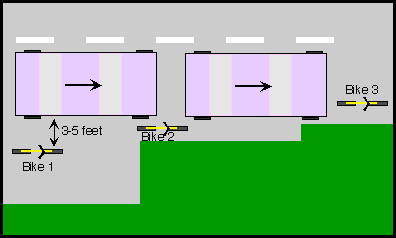
In this figure,
- Bike 1 is in an appropriate position, with ample clearance from motor vehicles, and with amble clearance from the curb.
- Bike 2 has left enough room so that vehicles will try to "squeak" by, passing dangerously closely on one side while right next to the curb on the other.
- Bike 3 has used the full lane (in this case, because the lane is so narrow that passing is not possible no matter where Bike 3 goes). While the car should follow with more of a gap than shown in the figure, as long as the car is moving at the same speed as the bicycle, there is no risk to the cyclist: the driver knows the cyclist is there and will pass when safe by crossing at least partially into the next lane.
3.3 Changing Lanes
In order to avoid miscommunication of intentions with drivers, experienced cyclists will change lanes as follows, and drivers should be aware of this practice:
- The cyclist should first look over a shoulder to see if there are overtaking vehicles.
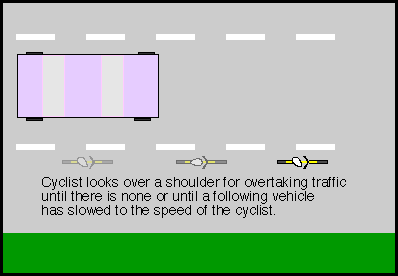
In some conditions (particularly near reflector dots or when it is necessary to brake), a cyclist may not be able to give a normal hand signal. If a cyclist looks alternately over his/her shoulder or straight ahead, drivers should interpret that as a signal. The cyclist will probably take some concrete indication from the driver, such as slowing to the cyclist's speed, as an indication that the driver will "let" the cyclist into the lane. - Once the cyclist has determined that a lane change is safe, the cyclist can cross the lane stripe. The cyclist may check again by looking over a shoulder before preceeding across the lane.
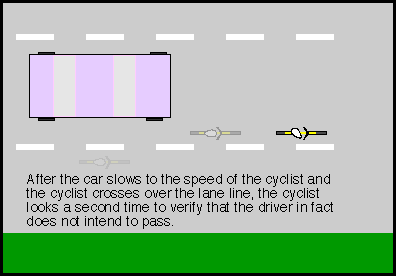
3.4 Intersections
Expert cyclists will typically choose a path through an intersection (as allowed by traffic laws) so as to minimize the number of lane changes. In the typical intersection, this means that
- right-turning bicycles will typically be on the right side of the right lane.
- bicycles proceeding straight will typically be in the lane furthest to the right from which continuing straight is permitted. The appropriate position in the lane depends on whether a right turn is permitted from this lane:
- if no right turns are permitted, the cyclist will typically be near the right edge of the lane.
- if right turns are permitted, the cyclist will typically stay far enough to the left to discourage right-turning drivers from cutting the cyclist off.
- left-turning bicycles will typically be in the rightmost lane from which a left turn is permitted. In this case,
- if the lane is a left-turn-only lane, the cyclist will typically be at its right edge.
- if the lane allows both left-turning and "through" traffic, then the cyclist will typically stay far enough right to discourage a left-turning car from turning in front of the cyclist.
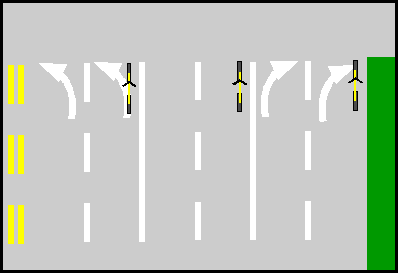
For the case where there is a lane that can be used by turning and "through" traffic, the positions are illustrated in the next diagram.
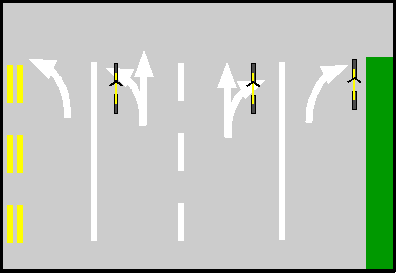
A cyclist will ideally be in a position in the lane so that drivers will not cut the cyclist off by turning across the cyclist's path. When stopped (at a stop sign or red light), expert cyclists will often wait in the center of the lane. Then if a car that is about to turn shows up, you can move the bicycle to the side to let the car by. Cyclists who do this will look over their shoulders to check the turn signal, so it is important to use the turn signals even though the cyclist is ahead. Once the cyclist can proceed, the cyclist will move to the normal position on the roadway.
3.5 Riding in Traffic
While, as stated above, a cyclist may use a full traffic lane when the lane is too narrow to share with a motor vehicle, a cyclist may also ride in the stream of traffic when going as fast as motor vehicles. The following figure shows why This is necessary.
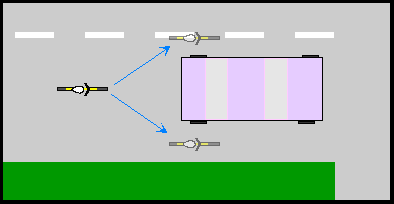
Note how the cyclist is in a position where the vehicle ahead cannot cut the cyclist off by turning. Drivers should expect to see cyclists riding in this way.
|